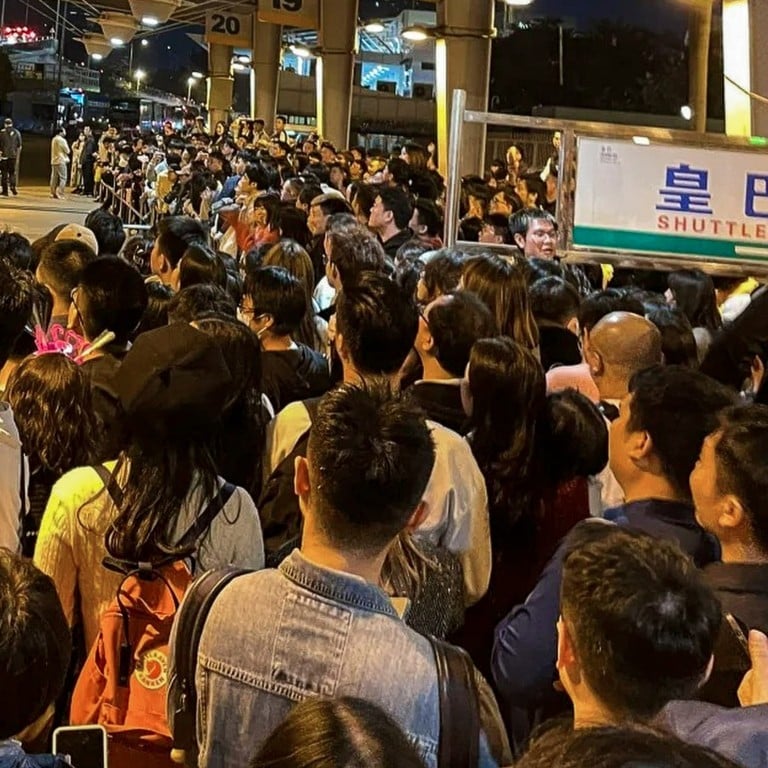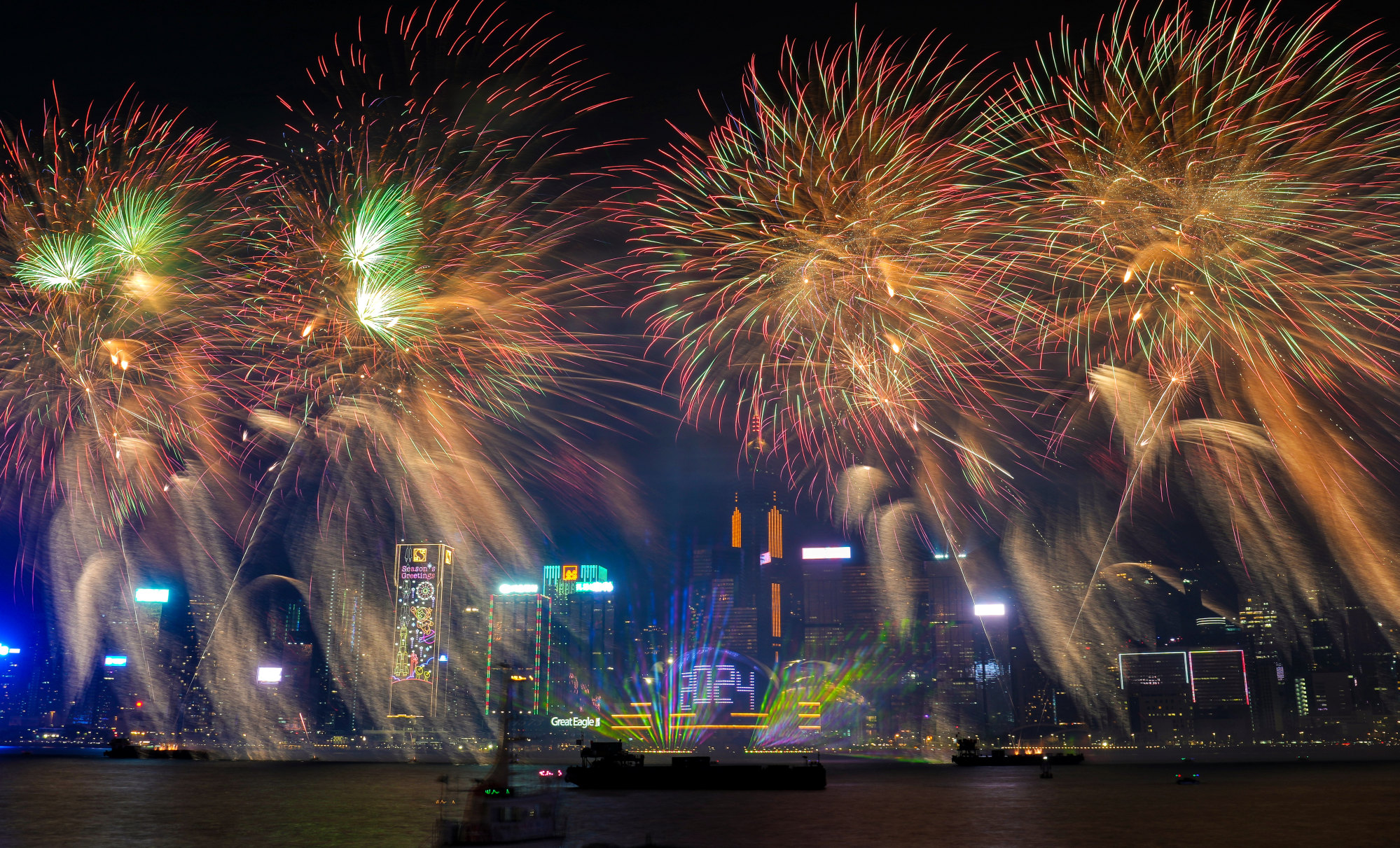
Hong Kong security chief to review why thousands left stranded at train station, stuck at mainland Chinese border after New Year’s Eve fireworks
- Tourists at Lok Ma Chau border crossing faced delays and others were stuck overnight at Sheung Shui MTR station amid high turnout for New Year’s Eve celebrations
- Transport Department expresses concerns over long waiting times at border as security chief says government will review how to improve crowd handling
Hong Kong’s security chief on Monday vowed to review why thousands of mainland Chinese visitors were left stranded at a train station or delayed at the border as they returned home from New Year’s Eve celebrations that drew 223,000 tourists to the city.
Secretary for Security Chris Tang Ping-keung said officials would look into how the relevant government departments could ensure a smoother handling of crowds at control points to prevent long waiting times.
“Other than the existing control points operating 24 hours a day, we are discussing with mainland authorities about extending the arrangement to other checkpoints,” he said.

The Tourism Board in the morning said the number of single-day arrivals that had flocked to Hong Kong as of 10pm on Sunday was the highest figure for 2023, attributing the influx to what it called the “biggest-ever” New Year’s Eve fireworks.
The “New Year, New Legend” fireworks display, which kicked off at midnight and lasted about 12 minutes, drew 479,000 revellers to both sides of Victoria Harbour, the board said.
According to the Immigration Department, 195,888 visitors from the mainland came to the city on Sunday, accounting for 87 per cent of total tourist arrivals.
Despite MTR train services operating throughout the night, services to the border stations of Lo Wu and Lok Ma Chau Spur Line checkpoints are unavailable overnight, resulting in crowds of people gathering at the Sheung Shui stop to wait for the first cross-border train on Monday morning.
Hong Kong’s New Year countdown party to bring back harbour fireworks
Some internet users complained on mainland social media platform Xiaohongshu that they had waited five hours at the border before they got home, sharing footage of the crowds.
“From Tsim Sha Tsui MTR [station] to Huanggang, it took me five hours to leave the checkpoint after watching the fireworks,” an internet user with the account name Coco963 said. “What a New Year’s celebration!”
Zhang Huiyan, a school assistant in Shenzhen, said she arrived home in Luohu at around 6.30am on Monday after watching the fireworks in Tsim Sha Tsui and had travelled back on a cross-border coach heading to Huanggang.
“I waited at least four hours to get on the bus on Austin Road after the fireworks ended,” the 46-year-old said. “There were at least 400 people queuing at one point.”
Zhang boarded her bus at around 4.30am and got stuck in a traffic jam near the Lok Ma Chau checkpoint, with the passengers only clearing customs after another 45 minutes.
“I would have booked a hotel room if I had known about the chaos,” she said. “It normally takes me an hour to commute from Hong Kong to Huanggang.”
Hong Kong Guangdong Boundary Crossing Bus Association secretary Freeman Cheung Kim-ping said operators had increased the number of buses on New Year’s Eve, but it was not enough to meet the high demand, especially in Tsim Sha Tsui and Mong Kok.
“Hong Kong has not held New Year’s Eve fireworks countdown events for years, which made it difficult for operators to anticipate the number of passengers,” he said. “Even with our vehicles ready, the roads were slow to reopen and resulted in a backlog of a large number of passengers.”
A severe traffic jam took place along San Sham Road, near the Lok Ma Chau checkpoint, with the journey time for private motorists crossing the border increasing from the standard 45 minutes to three hours that night, Cheung added.
“The delay prevented the drivers from returning to the departing stations on time,” he said. “We are also the victims in this situation. The drivers were supposed to take at least six trips. Many of them ended up with just two.”

The Transport Department on Monday also expressed concerns about the long waiting times to cross the border, despite the number of overnight buses being increased to prepare for New Year’s Eve.
The number of mainland-bound travellers at the Lok Ma Chau crossing was more than expected, resulting in traffic jams that spilled onto the Sun Tin Highway and extended waiting times for cross-border coaches, it said.
The department added that it would review the situation and work with service operators and other government bodies to improve upon cross-border travel arrangements.
As the MTR services between Sheung Shui and the checkpoints at Lo Wu and Lok Ma Chau Spur Line commenced after 5.30am, crowds gathered at the concourse of Sheung Shui railway station, spilling over into outdoor areas before dawn.
At the Sheung Shui MTR station, people with babies and luggage were seen sleeping or sitting on the ground.
Hundreds of Hongkongers tour newly-opened border town on New Year’s Day
Many were waiting for the first train to the Lo Wu control point. The checkpoint only runs between 6.30am and midnight. Others were trying to catch the first train to the Lok Ma Chau Spur Line connecting Shenzhen’s Futian, with the control point operating from 6.30am to 10.30pm.
Lawmaker Dominic Lee Tsz-king urged authorities to explore the possibility of providing overnight railway and customs services at the Lo Wu checkpoint, since the city would host another fireworks display on February 12 during the Lunar New Year break.
“The Culture, Sports and Tourism Bureau can take on the additional responsibility of providing transportation services by arranging for travel agencies to bring passengers back to the mainland and to avoid similar chaos occurring during the Lunar New Year,” he said.
Last month, the National Development Reform Commission, the mainland’s planning agency, said it intended to have more land checkpoints with the city that operated 24 hours a day to boost connectivity with the Greater Bay Area, a new economic zone combining Hong Kong, Macau and nine cities in Guangdong.
Hong Kong to finish 2023 with warmest New Year’s Eve on record at 25.7 degrees
Out of Hong Kong’s 14 control points, only four work around the clock, namely Hong Kong International Airport, Lok Ma Chau control point, Macau Ferry Terminal in Sheung Wan and Hong Kong-Zhuhai-Macau Bridge.
Gary Ng Cheuk-yan, a senior economist for Asia-Pacific at Natixis Corporate and Investment Bank, said the overcrowded crossings after the fireworks reflected changing consumption preferences among tourists.
“The immediate economic impact generated by daytrips for fireworks was no longer as significant as the benefits derived from overnight stays,” he said.
“Businesses are likely to feel the number of visitors has increased, but the boost in spending has not caught up at the same pace.
“If Hong Kong stays attractive for its events, it will still see opportunities for returning visitors. The question is then: ‘how to attract visitors to stay longer amid structurally changing consumer preferences?’”


